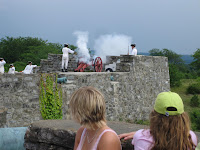Friday was cold and wet day in Canada. After waking up early, we headed out into a rainstorm to leave Quebec and return to the USA. It was raining solid all the way through Montreal and on to the border. There was a long line of cars to enter the USA where we did, mostly Canadians heading into the USA for the weekend. We made the border by Noon, but it was more than an hour to get across. But at least the rain stopped!
After a beautiful drive through the Adirondack Mountains in New York (our 8th state or province on this trek), we found our motel in Ticonderoga, New York. I've always wanted to see Fort Ticonderoga because of the remarkable military history of the area. Today was my chance!

Here is a picture of me on the lower wall at Fort Ticonderoga, looking south, getting ready to aim the cannon and fire on a sailboat anchored in the bay. This is Lake Champlain, near the inlet of La Chutes River from Lake George upstream.

Here is a picture of me on the lower wall at Fort Ticonderoga, looking south, getting ready to aim the cannon and fire on a sailboat anchored in the bay. This is Lake Champlain, near the inlet of La Chutes River from Lake George upstream.
This is a photo of a reenactment of the military parade grounds at Fort Ticonderoga. This is inside the fort looking toward the south barracks. As you can see, the actors were dressed in appropriate Continental dress.
Now the artillery regiment is taking aim at the sailboat! It looks like they may actually hit something! There were many cannons on the walls. After Ethan Allen and Benedict Arnold took Fort Ticonderoga from the British in 1775 (first battle fought and won in the Revolutionary War), General Washington ordered 69 cannons moved from Fort Ticonderoga to Cambridge, MA. There were still arms available in the fort to guard the way.
This is Fort Ticonderoga from the top of Mount Defiance, across the La Chutes River. The British put cannons on top of this mountain at one point to seige the fort. No one ever challenged the fort straight on, but it changed hands often during a 30 year period. Seige was the big enemy. I guess the soldiers never stored their year's supply of rations!

























